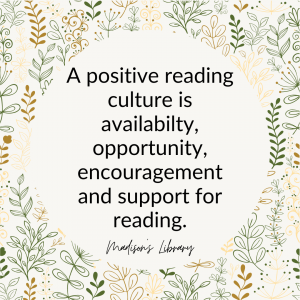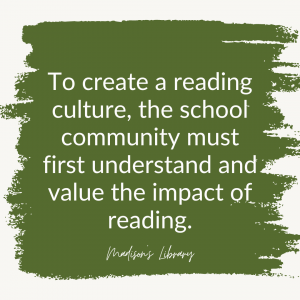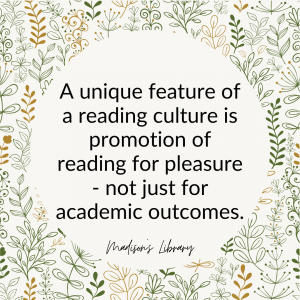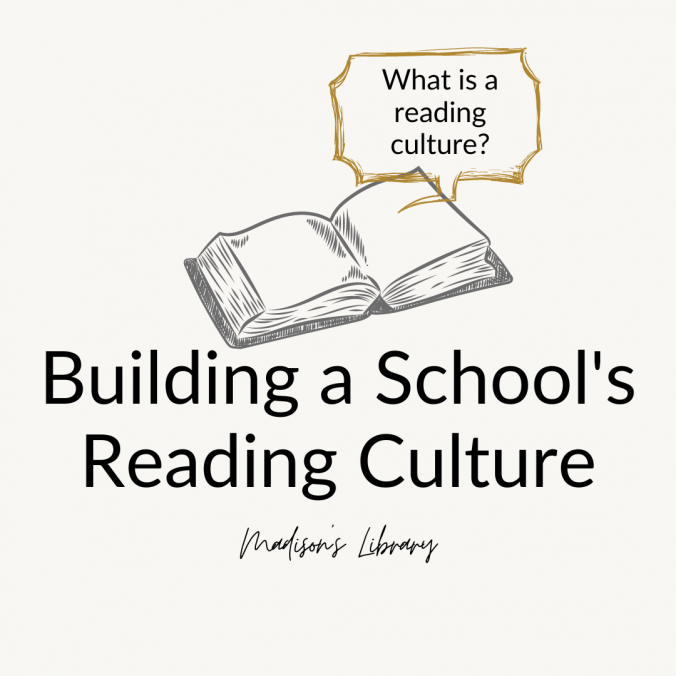Building A School Reading Culture – Part 4 What Is A Reading Culture?
In this series, which I started last year, I have been exploring building a strong reading culture in my school. It was something we had identified as a library team as a goal to work towards. You can read part one here. I then started to investigate organisational culture research and culture change research and methods. These have all given me some excellent information and starting points. It has also guided my practice for the last six months as I stepped into acting head of library and into a position to drive change.
Now it’s time to look a little more closely at reading cultures, what exactly a reading culture is and why is it something to strive towards.
What is a reading culture?
If culture can be defined as “the ways things are done here”, then a culture of reading is the tangible and visible expression of how all members of the school community value reading and engage with reading (Reading First, 2007). A positive reading culture provides support, encouragement, modelling, resources and opportunities to read for pleasure (Merga & Mason, 2019). School leaders prioritise and promote the will to read, as well as reading skill, and support staff to reflect this culture. Reading is seen and embedded across the school, in all classes, across all areas of the curriculum and the daily life of students (Daniels & Steres, 2011). Or, more concisely, a supportive school reading culture is availability, opportunity, encouragement and support for reading (Merga & Mason, 2019).
 A unique feature of a reading culture is that it promotes reading for leisure, rather than for just academic purposes or educational outcomes (Cochrane et al., 2022). Intrinsic student motivation for reading, reading engagement, autonomy, and student choice are also key features of a strong reading culture (Daniels & Steres, 2011).
A unique feature of a reading culture is that it promotes reading for leisure, rather than for just academic purposes or educational outcomes (Cochrane et al., 2022). Intrinsic student motivation for reading, reading engagement, autonomy, and student choice are also key features of a strong reading culture (Daniels & Steres, 2011).
How do you create a culture of reading?
To create a reading culture, the school community need to first understand the impact of reading on student achievement. There are many benefits of reading and research has shown that reading for pleasure is a strong and powerful predictor of academic, social and emotional skills, or as Dr Whisken (2021) so beautifully phrases it, reading is “an essential lifelong habit for enjoyment and gaining understanding about self and society and the natural world”.

Strong and supportive leadership is key in a whole school approach to building positive attitudes towards books and reading (Merga & Mason, 2019). A shared vision of the school’s reading culture, why reading culture is important and what an engaged reader looks like, as well as fully supporting the library and its resources, services and programs is key to building a reading culture (NLNZ, n.d.).
Daniels and Steres (2011) suggest three actions towards building a reading culture. 1. Make reading a school-wide goal and priority, allowing time and expectations for reading. 2. Provide ongoing support and training to staff to support readers, including how to talk to their students about reading and develop their own reading practices. 3. Commit resources, including time and money to ensure access and commitment to reading is evident and supported.
Building a reading culture involves dedicated time to read during the school day, student choice in reading material, school-wide support of reading, classroom libraries, promoting reading within the classroom and reading to be seen as important (Daniels & Steres, 2011).
Where does it leave the school library?
Consistent across the research is the emphasis on school-wide approaches. A reading culture must be visible across the whole school. Autonomy and choice drives motivation. When students are internally motivated to read, they are more likely to read (Daniels and Steres, 2011). So, if reading culture is a school-wide approach, to be led and directed by school leadership, included in the school vision and policies, where does this leave the school library?
 On one hand, the school library and school library team are ideally placed to promote and support reading (Loh et al., 2017). School library staff are literacy and literature experts, can provide support in terms of resources and knowledge about what books to read and how to talk to students about reading. School librarians are also ideally situated to promote student choice in reading and support this through a wide variety of resources (Merga & Mason, 2019). However, sometimes the school library and those working within it are not supported by their leadership team, or do not have an adequate budget to supply those resources to support choice. Further, if leadership at the school does not support or wish to prioritise a culture of reading at the school, it can feel like the school librarian has no place to disagree or spends much energy championing a cause that is ignored or actively disagreed with. So often, the school has other priorities, a new pedagogical approach, a drive towards wellbeing, or visible thinking. How then, does a culture of reading fit?
On one hand, the school library and school library team are ideally placed to promote and support reading (Loh et al., 2017). School library staff are literacy and literature experts, can provide support in terms of resources and knowledge about what books to read and how to talk to students about reading. School librarians are also ideally situated to promote student choice in reading and support this through a wide variety of resources (Merga & Mason, 2019). However, sometimes the school library and those working within it are not supported by their leadership team, or do not have an adequate budget to supply those resources to support choice. Further, if leadership at the school does not support or wish to prioritise a culture of reading at the school, it can feel like the school librarian has no place to disagree or spends much energy championing a cause that is ignored or actively disagreed with. So often, the school has other priorities, a new pedagogical approach, a drive towards wellbeing, or visible thinking. How then, does a culture of reading fit?
When I was going through my notes from last year about building a reading culture I found the following statement: “Move beyond library centric. Library is not the heart of the school. Reading is. But that happens in every classroom.” Part of this statement comes from an article by Dr Anne Whisken (2021), the other part from my own reflections. It’s an uncomfortable statement to sit with. As a librarian, passionate about school libraries, how on earth do I move away from being library centric? That’s the opposite of everything I am passionate about. But it also has a ring of truth to it. If a school is to truly have a positive and pervasive reading culture, it has to be school wide and school-driven. Supported by the library, yes. Promoted and enhanced by everything the school library does, yes. But the school library cannot be solely and wholly responsible for the school’s reading culture. I find this both a relief and a challenge. Should I give up now? Should I turn my attention outside the walls of the school library?
First I have to take a step backwards. I need to measure reading culture and assess the situation at my school before identifying how to move forward.
I’ll explore this in part 5 of my building a reading culture series.
References
Cochrane, L., Ozturk, O., Khataee, H., Al-Hababi, R., Al-Malki, F., & Nourin, H. (2022) Fostering a reading culture: evidence from Qatar Reads, Development Studies Research, 9(1), 82-94. doi. 10.1080/21665095.2022.2050774
Daniels, E., & Steres, M. (2011). Examining the effects of a school wide reading culture on the engagement of middle school students. Research in Middle Level Education Online, 35(2), 1–13. https://files.eric.ed.gov/fulltext/EJ951779.pdf
Florida Association of Supervisors of Media. (2021). Florida Power-Library School. https://www.flpowerlibraries.com/fplsapplication
Gonzales, J. & Peery, A. (2021). Does Your School Need A Literacy Check-Up? https://www.cultofpedagogy.com/literacy-check-up/
Loh, C.E., Ellis, M., Paculdar, A.A., & Wan, Z.H. (2017). Building a successful reading culture through the school library: A case study of a Singapore secondary school. IFLA Journal, 43(4), 19-31. https://repository.ifla.org/bitstream/123456789/350/1/ifla-journal-43-4_2017.pdf
Merga, M. K., & Mason, S. (2019). Building a school reading culture : Teacher librarians’ perceptions of enabling and constraining factors. The Australian Journal of Education, 63(2), 173–189. https://search-informit-org.ezproxy.slq.qld.gov.au/doi/10.3316/aeipt.224272
National Library New Zealand. n.d. A school-wide reading culture. https://natlib.govt.nz/schools/reading-engagement/understanding-reading-engagement/a-school-wide-reading-culture
Reading First. (2007.) Building a strong reading culture. What you can do. Sustainability Series, 1, September, 2007. https://www2.ed.gov/programs/readingfirst/support/culturebrief.pdf
Sharr, A. (2012) Introduction: a case for close reading in Sharr, A. (Ed.). (2012). Reading architecture and culture : Researching buildings, spaces and documents. Taylor & Francis Group.
Turkel, A., Ozdemir, E.E., & Akbulut, S. (2017). Validity and reliability study of reading culture scale. Turkish Studies, 12(14), 465-490. https://eric.ed.gov/?id=ED588050
Whisken, A. (2021). Framework for whole school wide reading practice. Synergy, 19(1). https://slav.vic.edu.au/index.php/Synergy/article/view/488



I’m loving this series Madison, and finding it fascinating! Can’t wait for the next instalment!
Thank you, Marie. It’s been a fun series to put together and helpful for my practice, so I’m glad it is interesting to others as well. Part five is coming soon.
I like your initiative. I am based in
a developing country and the
rate of illiteracy is high. Though I am working at an academic library, I have started a story telling project across different sectors of libraries. The purpose of this project is to promote story telling in libraries. I hope this initiative will result in the formation of story telling clubs in libraries which will trigger reading habits.
I think that the quote you used proposes an interesting idea to state that reading is the true heart of the school instead of libraries. But I’d alter it some to say that libraries are still the heart of the school but reading is the lifeblood, flowing through every classroom and every facet of the school. Without it everything falls apart, just like if our blood stops flowing. We need that coexistence of the library heart pumping the reading blood out to our community for a school to truly function well!
Thank you so much for your comment. I went back and reread that paragraph. It’s an interesting and challenging point isn’t it? You make some excellent arguments. I have to agree that reading isn’t the heart of the school (that came from Dr Whisken), I guess what I was referring to from my perspective in that was that I’ve never felt right about calling the library the heart of the school. I usually refer to my library as the hub of the school, similar connotations but a slight different, but you certainly make a great case for it.